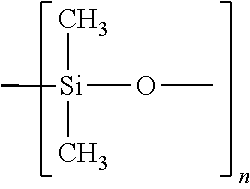Adhesive and sealant systems
- Summary
- Abstract
- Description
- Claims
- Application Information
AI Technical Summary
Problems solved by technology
Method used
Image
Examples
example 1
Procedure
[0135]Direct addition of the silica to the epoxy resin. Total wetting of the silica with the resin in a high-speed laboratory mixer (diameter 5 cm, Cowles disc) at 1000 rpm. Measurement of the incorporation time. Dispersion in the high-speed laboratory mixer at 3000 rpm, 5 min. Then aeration of the samples. Storage of the resin / silica mixture for 1.5 h at 25° C., then incorporation of the hardener component heated to 25° C. for 1 min at 1000 rpm; measurement of the viscosity with a Brookfield rotary viscometer at 2.5 rpm and 20 rpm, immediately after addition of the hardener and after 15 min, 30 min and 45 min. Calculation of the thixotropy indexes.
[0136]
TABLE 2Test results from Example 1Test resultsViscosity inViscosity inPas beforePas afterIncorporationaddition ofaddition ofDescriptiontime in sec.hardenerThix. indexhardenerafter 15 min30 min45 minSample 1:1423985.251484745Aerosil ® R202Sample 2:1403985.250474644Aerosil ® R 202 VV 60Sample 3:343685.149484543Aerosil ® R 202...
example 2
Adhesives Based on Epoxy Resin
[0139]The AEROSIL® substances used are pyrogenically produced silicon dioxides:[0140]AEROSIL® R 202[0141]AEROSIL® R 202 VV 60[0142]AEROSIL® R 202 VV 90[0143]AEROSIL® R 805[0144]AEROSIL® R 805 VV 60[0145]AEROSIL® R 805 VV 90
Procedure:
Test Formulation for Epoxy Resin
[0146]
Component A:92.0% Araldit M (bisphenol A resin)(resin component)8.0% AEROSIL ® R 202 (pyrogenic silica)Component B:90.9% Euredur 250 (polyaminoamide hardener)(hardener comp.)9.1% HY 960 (tert. amine as accelerator)
[0147]Direct addition of the silica to the epoxy resin. Total wetting of the silica with the resin in a high-speed laboratory mixer (diameter 5 cm, Cowles disc) at 1000 rpm. Measurement of the incorporation time. Dispersion in the high-speed laboratory mixer at 3000 rpm, 5 min. Then aeration of the samples. Storage of the resin / silica mixture for 1.5 h at 25° C., then incorporation of the hardener component heated to 25° C. for 1 min at 1000 rpm; measurement of the viscosity wi...
example 3
[0151]Weighing out of Desmoseal M 100, followed by Mesamoll. Addition of Dynasylan Glymo, followed by homogenisation with a high-speed laboratory mixer at 1000 rpm. Addition of Omya BLP-3 and homogenisation with the high-speed mixer at 1000 rpm. Addition of AEROSIL®. Homogenisation with the high-speed mixer at 1000 rpm and dispersion for 10 min. at 3000 rpm in vacuo. Determination of rheological properties at 25° C. and of the flow behaviour in accordance with ASTM-D-2202. In this test the sealant is introduced into a standardised test block and stored in a vertical position at room temperature. The distance traveled by the lower edge of the sealant in the block is measured in mm.
[0152]The AEROSIL® substances used are pyrogenically produced silicon dioxides:[0153]AEROSIL® R 202[0154]AEROSIL® R 202 VV 60[0155]AEROSIL® R 202 VV 90
[0156]A simple 1-component polyurethane sealant formulation based on Desmoseal M 100 is used for the examples, it also being possible to use MDI prepolymers ...
PUM
| Property | Measurement | Unit |
|---|---|---|
| Density | aaaaa | aaaaa |
| Density | aaaaa | aaaaa |
| Density | aaaaa | aaaaa |
Abstract
Description
Claims
Application Information
 Login to View More
Login to View More - R&D
- Intellectual Property
- Life Sciences
- Materials
- Tech Scout
- Unparalleled Data Quality
- Higher Quality Content
- 60% Fewer Hallucinations
Browse by: Latest US Patents, China's latest patents, Technical Efficacy Thesaurus, Application Domain, Technology Topic, Popular Technical Reports.
© 2025 PatSnap. All rights reserved.Legal|Privacy policy|Modern Slavery Act Transparency Statement|Sitemap|About US| Contact US: help@patsnap.com



